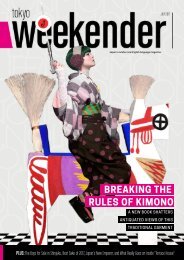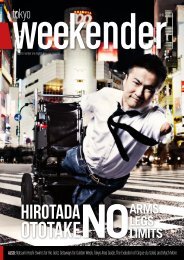Tokyo Weekender - October 2017
A day in the life of a geisha. Find your perfect Kyushu. Plus Q&A with anime director Keiichi Hara, are robots taking our jobs?, Explore Japanese cuisine at GINZA SIX, and Tsukuda guide
A day in the life of a geisha. Find your perfect Kyushu. Plus Q&A with anime director Keiichi Hara, are robots taking our jobs?, Explore Japanese cuisine at GINZA SIX, and Tsukuda guide
Create successful ePaper yourself
Turn your PDF publications into a flip-book with our unique Google optimized e-Paper software.
The Future<br />
of Japanese<br />
Football<br />
Meet the man who believes he can transform the game<br />
Words by Matthew Hernon<br />
It's been almost a quarter of a century<br />
since the launch of the J-league and<br />
though not as glamorous as it once was,<br />
it's arguably in a better place now than it<br />
has ever has been. Like the current Chinese<br />
Super League, the early initiative was to<br />
bring in an array of high-profile players such<br />
as Zico, Gary Lineker, and Hristo Stoichkov<br />
to entice large crowds. For a brief time, it<br />
worked, but in a struggling economy it was<br />
unsustainable and the novelty began to wear<br />
off in the mid-Nineties.<br />
With the big names departing, attendances<br />
plummeting and clubs’ sponsors pulling<br />
the plug on their investments, the League<br />
decided to change its approach. The focus<br />
switched from the superstar individuals and<br />
became more about the teams, who were<br />
encouraged to build close ties with their local<br />
communities.<br />
It was all part of the 100 Year Vision project<br />
that was announced towards the end of<br />
the 20th century aimed at making 100 professional<br />
teams by 2092. At the time, many saw<br />
it as overly ambitious; however, with 54 sides<br />
currently spread out over three divisions,<br />
the plan looks like it could come to fruition<br />
sooner than expected.<br />
When viewing the League from a domestic<br />
perspective, there's a lot to be positive<br />
about. Attendances have been steadily<br />
increasing (the J1 average this season is, at<br />
the time of writing 1,000 higher than the last<br />
campaign), title races are often unpredictable,<br />
and exciting young players are emerging<br />
all the time. Japanese football is popular in<br />
certain Asian countries and does have something<br />
of a cult following elsewhere, but could<br />
it be doing more to attract greater interest<br />
from the rest of the world?<br />
Takehiko Nakamura certainly thinks<br />
so. The New York-based president, CEO and<br />
founder of sports management consulting<br />
firm Blue United Corporation has a wealth<br />
of experience in the game, having worked in<br />
management roles for Major League Soccer<br />
in the US and FC Barcelona. The man chiefly<br />
responsible for bringing former Italian World<br />
30 | OCTOBER <strong>2017</strong> | TOKYO WEEKENDER
















